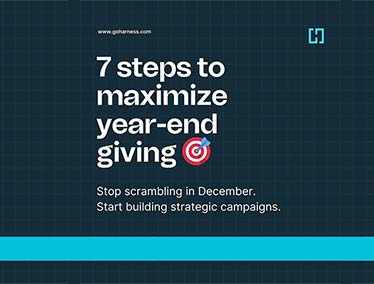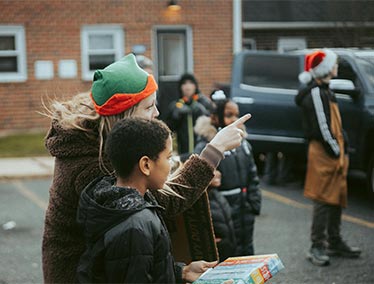The One Big Beautiful Bill fundamentally changed charitable giving incentives—and most nonprofits are still operating like nothing happened.
On July 4, 2025, The administration signed the One Big Beautiful Bill (OBBB) into law, permanently extending most Tax Cuts and Jobs Act provisions while introducing game-changing new rules for charitable giving.
Most critically, starting January 1, 2026, your $10,000-$100,000 donors will face new restrictions through a 0.5% AGI floor, while simultaneously, ALL of your smaller donors will gain access to a new permanent universal charitable deduction—up to $1,000 for single filers and $2,000 for married filing jointly.
The math tells a story of disruption that affects every nonprofit. A donor with $500,000 in AGI who gives $25,000 annually faces approximately $2,250 in reduced tax benefits when the AGI floor and benefit cap combine. Even donors giving $10,000 will see meaningful increases in their cost of giving. Yet the middle-income families who form your donor base—currently unable to claim any charitable benefit—will suddenly be able to deduct up to $2,000 in cash donations without itemizing.
According to the Independent Sector's analysis, fewer than 31% of nonprofits have begun adapting their fundraising strategies to this new reality. Those who start planning in October, rather than scrambling in December, position themselves to capture both major gifts before restrictions tighten and build sustainable monthly giving programs for the small-donor renaissance of 2026.
This isn't about reacting to change—it's about a sophisticated response to a transformation that's already here.
The OBBB Impact: A Tale of Two Donor Populations
The One Big Beautiful Bill represents the most significant charitable giving policy shift since the original TCJA in 2017. To understand its impact, we need to examine how it affects the donors who actually support small and medium-sized nonprofits.
What the OBBB Made Permanent
The legislation made permanent several TCJA provisions that were set to expire on December 31, 2025:
- Standard deductions set at $15,750 for single filers and $31,500 for married filing jointly in 2025 (OBBB increased these by $1,000/$2,000 from TCJA levels)
- The seven tax brackets (10%, 12%, 22%, 24%, 32%, 35%, 37%) continue unchanged
- The 60% AGI limit for cash charitable contributions to public charities made permanent
- Estate tax exemption set at $13.99 million for 2025, rising to $15 million per person in 2026 ($30 million per couple)
Important temporary provisions include:
- SALT deduction cap increased to $40,000 (from $10,000) for taxpayers earning under $500,000, but this increase expires in 2029 and reverts to $10,000 in 2030
These permanencies provide stability but maintain the status quo where only 10% of taxpayers itemize deductions—down from 31% before the TCJA.
The New Restrictions: Your Major Donors Face Real Impact
Starting January 1, 2026, even mid-level major donors will encounter two new hurdles that fundamentally alter the economics of giving:
The 0.5% AGI Floor For the first time in modern tax history, itemizers must exceed a threshold before claiming any charitable deduction. This impacts donors at every level:
- $200,000 AGI household: First $1,000 of donations provides zero tax benefit
- $300,000 AGI household: First $1,500 of donations provides zero tax benefit
- $500,000 AGI household: First $2,500 of donations provides zero tax benefit
- $1,000,000 AGI household: First $5,000 of donations provides zero tax benefit
For context, a successful small business owner or dual-income professional couple could easily reach $300,000-$500,000 AGI—these are your board members, annual fund leaders, and capital campaign donors.
The Joint Committee on Taxation projects this floor will raise $64.9 billion over ten years—revenue that previously subsidized charitable giving. This represents one of the largest structural changes to charitable tax incentives in decades.
The Combined Impact on Your Major Giving Program
Let's examine the real dollar impact for donors at levels typical for small and medium nonprofits:
$25,000 Annual Donor (with $500,000 AGI):
2025 Tax Benefit:
- Full $25,000 is deductible
- Tax benefit at 35% rate: $8,750
- Net cost of giving: $16,250
2026 Tax Benefit with OBBB:
- First $2,500 (0.5% of $500K AGI) provides no benefit
- Remaining $22,500 deductible at 35%: $7,875
- Net cost of giving: $17,125
- Additional cost to donor: $875 (5.4% increase)
$10,000 Annual Donor (with $300,000 AGI):
2025 Tax Benefit:
- Full $10,000 is deductible
- Tax benefit at 32% rate: $3,200
- Net cost of giving: $6,800
2026 Tax Benefit with OBBB:
- First $1,500 (0.5% of $300K AGI) provides no benefit
- Remaining $8,500 deductible at 32%: $2,720
- Net cost of giving: $7,280
- Additional cost to donor: $480 (7% increase)
These may seem like small amounts, but for donors giving at these levels, every dollar matters. More importantly, the psychological impact of "losing" tax benefits can significantly affect giving decisions.
For ultra-high-net-worth donors giving seven figures, the combined impact creates even more dramatic reductions—approximately $23,500 per million donated—though these donors are less common for most nonprofits.
The New Opportunity: Universal Charitable Deduction
While your major donors face new restrictions, the OBBB creates an unprecedented opportunity to engage your entire donor base through the universal charitable deduction:
Starting January 1, 2026:
- Single filers can deduct up to $1,000 in cash charitable contributions
- Married filing jointly can deduct up to $2,000 in cash contributions
- This deduction is "above the line"—available regardless of itemization
- Critical limitations:
- Cash only (no appreciated securities or property)
- Direct gifts to public charities only
- Explicitly excludes donor-advised funds, private foundations, and supporting organizations
According to Fidelity Charitable, when a similar $300 deduction was available during COVID-19 under the CARES Act, approximately 90 million taxpayers claimed it in 2020-2021. While the Tax Policy Center found that this provision increased total charitable deductions by only 5% in 2020, the new deduction is more than triple the size and permanent. The Joint Committee on Taxation estimates this universal deduction will cost $73.75 billion over ten years, suggesting significant anticipated usage.
The Psychology of the Perfect Monthly Gift
The universal deduction creates natural monthly giving targets perfectly sized for small and medium nonprofits:
- $83/month ($996 annually) maximizes the single filer benefit
- $167/month ($2,004 annually) maximizes the married filing jointly benefit
These amounts hit a psychological sweet spot—substantial enough to feel meaningful, affordable enough for middle-income households, and perfectly aligned with the tax benefit ceiling. For organizations that typically see average gifts of $250-$500, these monthly amounts represent sustainable, predictable revenue.
Strategic Response: The Dual-Track Approach
The OBBB's divergent impact on different donor segments demands a sophisticated response. Organizations must build two parallel strategies starting in October: optimizing major gifts before restrictions and launching monthly programs for the new universal deduction.
The key is recognizing that these aren't competing priorities but complementary opportunities. Your $10,000+ donors need help navigating new restrictions through strategies like bunching and asset gifts. Your broader donor base needs education about the new universal deduction and an easy way to maximize it through monthly giving.
Looking Ahead: The Post-OBBB Reality for Small Nonprofits
The OBBB creates unique opportunities for small and medium nonprofits willing to adapt:
The Great Equalizer
The universal charitable deduction levels the playing field:
- Large nonprofits can't monopolize tax benefits
- Every organization can offer tax advantages
- Monthly giving programs become competitive advantages
- Small donors become more valuable
The Relationship Premium
As tax benefits become more complex, donors will value organizations that help them navigate changes:
- Personal guidance matters more
- Trust becomes competitive advantage
- Early adopters gain loyalty
- October education builds long-term relationships
The Great Giving Democratization of 2026
The universal charitable deduction could reverse a decade-long trend of giving concentration among the wealthy. Consider these projections:
Pre-OBBB Reality (2018-2025):
- 20% of households give 80% of charitable dollars
- 10% of taxpayers claim charitable deductions
- Average household giving: $2,500 annually
- Participation rate declining 1.5% yearly
Post-OBBB Potential (2026+):
- 100 million households gain tax incentives
- Middle-income giving could increase 25%
- Monthly giving programs could triple in size
- Participation rate stabilization or growth
Organizations building monthly giving infrastructure now will be ideally positioned to capture this wave.
Conclusion: October Sets the Stage for Sophisticated Response
The One Big Beautiful Bill didn't just change tax law—it fundamentally rewired charitable giving incentives in ways that affect every nonprofit, regardless of size. As Fidelity Charitable emphasizes, 2025 represents "a potentially strategic time to give" before new restrictions take effect.
For small and medium nonprofits, the math is compelling and relevant. Your $10,000-$50,000 donors face real increases in giving costs—$500 to $2,500 more to maintain their current giving. Most of your smaller donors gain unprecedented tax benefits that make monthly giving attractive for the first time. But beyond the numbers, this is about demonstrating that even smaller organizations can provide sophisticated guidance and strategic thinking.
October isn't about having perfect technology or large teams. It's about starting conversations early, providing clear information, and helping donors at every level navigate change with confidence.
The organizations that act in October—that educate their $10,000 donors about bunching, that launch monthly giving programs for everyone else, that prove small nonprofits can be strategically sophisticated—these are the organizations that will thrive in the post-OBBB world.
The new reality requires a sophisticated response. October is when that response begins.
For nonprofits ready to maximize both major gifts and monthly giving through strategic tax planning, the time to act is now. Organizations using comprehensive platforms with tax optimization tools, sophisticated segmentation, and automated monthly giving systems report significantly better results in navigating this transition.
Disclaimer: This blog post is provided for informational and educational purposes only. It does not constitute legal, tax, or accounting advice, and should not be relied upon as such. Nonprofits and donors should consult their own professional advisors to understand how the One Big Beautiful Bill and related tax provisions apply to their specific circumstances.





